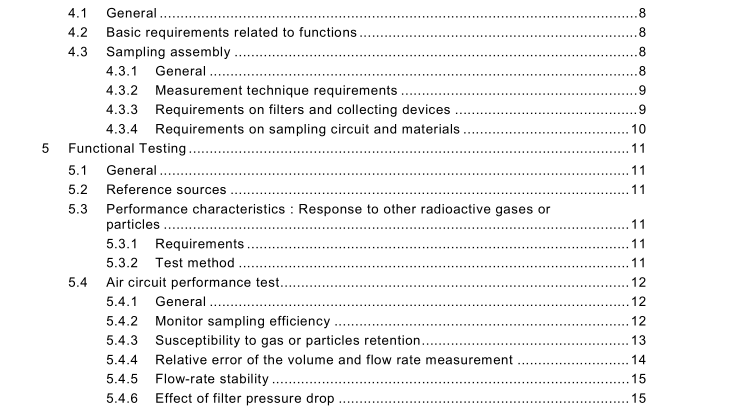BS IEC 60951-2:2009 pdf download – Nuclear power plants Instrumentation important to safety — Radiation monitoring for accident and post-accident conditions — Part 2: Equipment for continuous off-line monitoring of radioactivity in gaseous effluents and ventilation air
1 Scope
This part of IEC 60951 provides general guidance on the design principles and performance criteria for equipment for continuous off-line monitoring of radioactivity in gaseous effluents and ventilation air used in nuclear power plants for accident and post-accident conditions. General requirements for technical characteristics, test procedures, radiation characteristics, electrical, mechanical, and environmental characteristics are given in IEC 60951 -1 . These requirements are applicable in this part unless otherwise stated. This standard is applicable to:
• noble gas activity monitors intended to measure the volumetric activity of radioactive noble gases in gaseous effluents at the discharge point and the variation of volumetric activity with time during accident and post-accident conditions. The monitor may also be used for the determination of the total discharge of noble gas activity over a given period;
• noble gas, aerosol and specific nuclide (commonly iodine, in its different forms: inorganic iodine, organic iodine and iodine sticking on dust) monitors intended to measure the volumetric activity in air or gas systems (control room ventilation, reactor leakage collection, drywell ventilation exhaust, fuel handling building ventilation exhaust, reactor building ventilation purge exhaust) and detect any significant increase of radioactivity during or after an accident. This standard is only applicable to continuous off-line measurement, i.e. monitors whose detector measures a representative proportion of the main effluent or ventilation stream at some remote location (sampling assembly). It does not apply to monitors with the detector positioned in or adjacent to the effluent or ventilation stream, which are within the scope of IEC 60951 -4. Sample extraction and laboratory analysis, which are essential to a complete programme of effluent monitoring, are not within the scope of this standard.
2 Normative references
The following referenced documents are indispensable for the application of this document. For dated references, only the edition cited applies. For undated references, the latest edition of the referenced document (including any amendments) applies.
IEC 60951 -1 :2009, Nuclear power plants – Instrumentation important to safety – Radiation monitoring for accident and post-accident conditions – Part 1: General requirements IEC 61 226, Nuclear power plants – Instrumentation and control systems important to safety – Classification of instrumentation and control functions
3 Terms and definitions
For the purposes of this document, the terms and definitions given in IEC 60951 -1 apply.
4 Design principles
4.1 General
The general requirements of IEC 60951 -1 are applicable to all types of monitors within the scope of the present standard, unless otherwise stated.
4.2 Basic requirements related to functions The equipment will typically measure levels of activity in engineered gaseous discharge routes, such as reactor or fuel handling buildings, and ventilation ducts and stacks. It is intended to provide, depending on the required function, a measure of activity discharged to the environment or detection and quantification of leakage in containment barriers, and any useful information on the behaviour of the plant, which causes or allows the activity release. The measurement of activity discharge to the environment should ideally be comprehensive, but since measurement of halogen and particulate activity released in effluents during an accident is more complex, it is often judged that monitoring only noble gases will be sufficient.
Therefore, monitors should be capable of detecting and measuring gaseous effluent radioactivity with compositions ranging from fresh equilibrium noble gas fission product mixtures to 1 0 days old mixtures. Multiple instruments may be needed to cover the effective range of measurements required. Since the measurement is continuously carried out on a sample of effluent or ventilation transferred to a remote location, the detection and measurement assembly shall be installed in an accessible location and in an environment which is compatible with the equipment design limits specified in this standard. This shall be also applicable to the active parts of the sampling assembly (pumps, flow control instruments) requiring maintenance. The other part of the sampling assembly (sampling probe, pipework) may be designed for and located in a harsh environment. In this case, if the monitor is classified according to the guidance of IEC 61 226, it should be classified at the same level as the monitor.
If qualification is needed, the part of the sampling assembly located in the harsh environment should be environmentally qualified to these specific ambient conditions. If necessary, the system shall indicate a value related to the measured volumetric activity under the conditions of temperature and pressure at the sampling location, agreed upon between the manufacturer and purchaser. They shall also agree on how to correct the expression of measurement if the conditions inside the measuring assembly are different from the calibration conditions.BS IEC 60951-2:2009 pdf download
